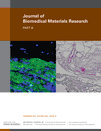A tissue-engineered aneurysm model for evaluation of endovascular devices †
How to cite this article: Touroo JS, Williams SK. 2012. A tissue-engineered aneurysm model for evaluation of endovascular devices. J Biomed Mater Res Part A 2012:100A:3189–3196.
Abstract
Endovascular stent grafts used for treatment of arterial aneurysms require preclinical testing for investigation of biological responses following implantation. The preclinical evaluation process related to the safety and efficacy of these devices is limited by the absence of an in vitro aneurysmal blood vessel equivalent capable of providing high-throughput, cost-effective assessments. With this in mind, the focus of this work was to develop an aneurysm model consisting of human blood vessel cells. To create aneurysmal scaffolds, expanded polytetrafluoroethylene vascular grafts were dilated utilizing an angioplasty balloon. Stromal vascular fraction cells isolated from human adipose tissue were integrated with the scaffolds, and luminal flow of nutrient medium was executed for 14 days in a vascular bioreactor. Following bioreactor perfusion, histology verified that a neointimal lining of human tissue had formed. Immunohistochemistry and scanning electron microscopy revealed a flow-contacting layer of smooth muscle cells, characterizing the model as a representation of neointimal formation in an injured or diseased vessel. This study has demonstrated the engineering of a vascular construct containing an aneurysmal dilation. A tissue-engineered aneurysm model could provide an alternative to current nonbiological in vitro aneurysm models and serve as a practical tool in the progression of new devices toward in vivo studies. © 2012 Wiley Periodicals, Inc. J Biomed Mater Res Part A: 100A:3189–3196, 2012.




